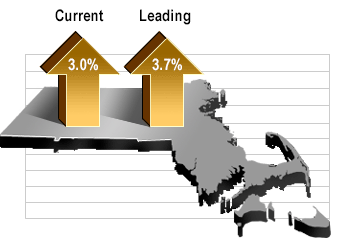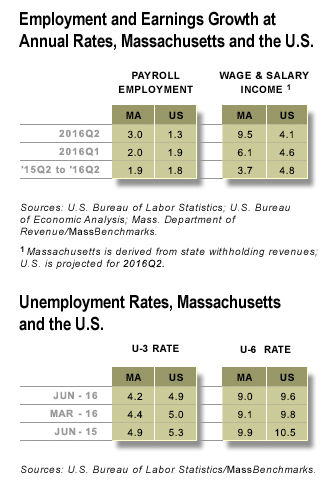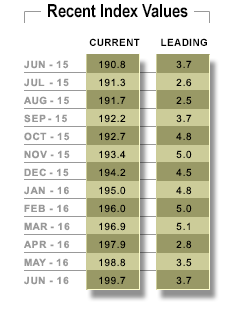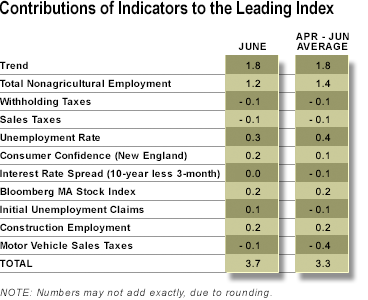State economy outpaces the U.S. in 2nd quarter
While unemployment is at its lowest level in nearly 15 years, risks to the downside abound.
June 2016
 Massachusetts real gross domestic product grew at an annual rate of 3.0 percent in the second quarter of 2016 according to the MassBenchmarks Current Economic Index. In contrast, according to the U.S. Department of Commerce, national real gross domestic product grew at an annual rate of 1.2 percent during the same period. MassBenchmarks, a journal of the Massachusetts economy, is published by the UMass Donahue Institute in collaboration with the Federal Reserve Bank of Boston.
Massachusetts real gross domestic product grew at an annual rate of 3.0 percent in the second quarter of 2016 according to the MassBenchmarks Current Economic Index. In contrast, according to the U.S. Department of Commerce, national real gross domestic product grew at an annual rate of 1.2 percent during the same period. MassBenchmarks, a journal of the Massachusetts economy, is published by the UMass Donahue Institute in collaboration with the Federal Reserve Bank of Boston.
State economic growth appears to have continued at a moderate pace in the second quarter of this year. Although the underlying indicators were mixed, both employment and earnings grew strongly, while the unemployment rate fell. Payroll employment expanded at a 3.0 percent annual rate in the second quarter, up from 2.0 percent in the first quarter. Total employment in the second quarter was 1.9 percent higher than in the same period last year. Wage and salary income, as estimated from state withholding tax revenue, expanded at a 9.5 percent annual rate in the second quarter, after growing 6.1 percent in the first quarter. Year over year, wage and salary income was 3.7 percent higher than in the second quarter of 2015.
 In contrast, U.S. jobs grew at a 1.3 percent annual rate in the second quarter, notably slower than the 1.9 percent rate of growth observed in the first quarter. U.S. employment in the second quarter of 2016 was 1.8 percent higher than in the second quarter of last year. MassBenchmarks estimates that U.S. wages and salaries grew at a 4.1 percent annual rate in the second quarter (U.S. personal income will be released on August 2), after growing 4.6 percent in the first quarter. Based on this estimate, national wage and salary income in the second quarter of 2016 was 4.8 percent higher than in the second quarter of last year.
In contrast, U.S. jobs grew at a 1.3 percent annual rate in the second quarter, notably slower than the 1.9 percent rate of growth observed in the first quarter. U.S. employment in the second quarter of 2016 was 1.8 percent higher than in the second quarter of last year. MassBenchmarks estimates that U.S. wages and salaries grew at a 4.1 percent annual rate in the second quarter (U.S. personal income will be released on August 2), after growing 4.6 percent in the first quarter. Based on this estimate, national wage and salary income in the second quarter of 2016 was 4.8 percent higher than in the second quarter of last year.
The state's headline unemployment rate—the U-3 measure—was 4.2 percent in June, down from 4.4 percent in March, and 4.9 percent in June of 2015. The U.S. unemployment rate in June was 4.9 percent, down from 5.0 percent in March, and 5.3 percent in June of last year. The Massachusetts rate is now lower than the pre-recession low of 4.6 percent in 2007, and is at the lowest level observed in nearly 15 years (the rate in September of 2001 was 4.1 percent).
The broader U-6 measure of unemployment, however, which includes those who are working part-time but want full-time work as well as those who are marginally attached to the labor force, remains significantly above pre-recession levels. MassBenchmarks estimates that the Massachusetts U6 rate inched down to 9.0 percent in June (from 9.1 percent in March) although it has declined by nearly a full percentage point since June of 2015 (when it was 9.9 percent). The U.S. rate in June was 9.6 percent, down from 9.8 percent in March and 10.5 percent in June 2015. Prior to the recession in 2007, the U-6 reached lows of 7.1 percent in Massachusetts and 8.0 percent in the U.S.
Consumer and business spending on items subject to the state regular sales tax posted another quarter of slower than average growth, although spending increased modestly during the second quarter. This measure of consumer spending grew at an 0.8 percent rate during the second quarter, following a decline of 6.1 percent in the first quarter. "Year over year, spending was flat, registering only 0.1 percent higher in the second quarter of 2016 than during the same period in 2015," noted Alan Clayton-Matthews, MassBenchmarks Senior Contributing Editor and Associate Professor of Economics and Public Policy at Northeastern University, who compiles and analyzes the Current and Leading Indexes. "This relatively poor performance was driven in part by a marked reduction in automobile purchases, which declined at a 6.4 percent rate in the second quarter of 2016. Notably, non-automobile spending increased 2.2 percent in the second quarter," he added.
 The MassBenchmarks Leading Economic Index is predicting that the state economy will continue to expand at a moderate pace over the next six months, at a 2.9 percent rate in the third quarter, and a 2.2 percent rate in the fourth quarter. The factors restraining growth are little changed from last quarter. One factor is the tightening labor market. With fewer unemployed workers and increasing retirements, it is becoming more difficult for employers to find the workers they need. This is reflected in the historically low levels of initial unemployment claims, a sign that employers are reacting to the tightening labor market by holding on to the workers they have.
The MassBenchmarks Leading Economic Index is predicting that the state economy will continue to expand at a moderate pace over the next six months, at a 2.9 percent rate in the third quarter, and a 2.2 percent rate in the fourth quarter. The factors restraining growth are little changed from last quarter. One factor is the tightening labor market. With fewer unemployed workers and increasing retirements, it is becoming more difficult for employers to find the workers they need. This is reflected in the historically low levels of initial unemployment claims, a sign that employers are reacting to the tightening labor market by holding on to the workers they have.
Another factor is slower worldwide economic growth. China's rapid pace of economic growth has decelerated, Japan's economy is growing very slowly, and the European economy remains sluggish. Adding risks to the downside is volatility in global financial markets. Although turmoil in stock markets in reaction to falling commodity prices—and more recently, the U.K.'s vote to exit the European Union—has calmed, risks related to the potential impact of weak global demand on corporate profits remain.
The Massachusetts Department of Revenue recently noted lower non-withholding income tax payments this tax season due to weaker than expected stock market performance. Given that uncertainty and volatility tend to dampen business confidence and investment, if this continues it may also begin to restrain consumer spending. Further, it appears that political uncertainty is also weighing heavily on the economic outlook. Recently, half of economists surveyed by the Wall Street Journal reported thinking that uncertainty related to the presidential election is having "detrimental" effects on the economy this year. For these reasons, the continued solid performance of the state economy, while cause for cautious optimism, remains vulnerable to these significant national and international risks to the downside.
 The 10 indicators that comprise the leading index usually do not all move in tandem. Typically, some may indicate an expectation of faster than average growth, while at the same time others may indicate an expectation of slower than average growth. The following table accounts for the contributions of each towards faster or slower growth than the trend of 1.8 percent. The index value is their sum.
The 10 indicators that comprise the leading index usually do not all move in tandem. Typically, some may indicate an expectation of faster than average growth, while at the same time others may indicate an expectation of slower than average growth. The following table accounts for the contributions of each towards faster or slower growth than the trend of 1.8 percent. The index value is their sum.
In June, six indicators contributed to a forecast of above-trend growth: total nonagricultural employment, the unemployment rate, consumer confidence, the Bloomberg stock index for Massachusetts, initial unemployment claims, and construction employment. One indicator, the interest rate spread between 10-year and 3-month U.S. Treasury securities, contributed to average-trend growth. Three indicators contributed to below-trend growth: withholding taxes, sales taxes, and motor vehicle sales taxes.
In the three-month period April through June, five indicators contributed to a forecast of above-trend growth: total nonagricultural employment, the unemployment rate, consumer confidence, the Bloomberg stock index for Massachusetts, and construction employment. Five indicators contributed to below-trend growth: withholding taxes, sales taxes, the interest rate spread between 10-year and 3-month U.S. Treasury securities, initial unemployment claims, and motor vehicle sales taxes.
The current and historical quarterly estimates for state domestic product growth include adjustments for changes in productivity growth. These adjustments are estimates of the quarterly deviations from the 1978-2015 trend in the growth of the ratio of output to employment and output to wage and salary income. In the second quarter of 2016 these adjustments subtracted 1.8 percentage points from growth. In the first quarter of 2016, these adjustments subtracted 2.4 percentage points from growth. For the forecast of state domestic product growth in the third and fourth quarters of this year, productivity growth is assumed to return to the average of the last five years.
Several recent months of the indices are revised each release. These revisions are a result of the statistical method used to create the index, as well as revisions in the underlying indicators.
--------
All of the indicators except interest rates refer to Massachusetts. The current index is composed of four indicators: nonagricultural employment, withholding taxes, sales taxes, and the unemployment rate. The leading index includes these four current indicators plus the other six (leading) indicators in the contributions table. All of the indicators are as of June, except for interest rates and the Bloomberg stock index for Massachusetts, which are through July 26. The MassInsight Consumer Confidence Index is released every third month. Intervening months are interpolated, and changes in the Conference Board's Consumer Confidence Index for the U.S. are used to extrapolate to the current month of the index, as needed. Series measured in current dollars or values, i.e., withholding taxes, sales taxes, the Bloomberg stock index, and motor vehicle sales taxes, are deflated by the U.S. consumer price index for all urban consumers, excluding food and energy.
For a description of the methodology used to construct these indices, see: Alan Clayton-Matthews and James H. Stock, "An application of the Stock/Watson index methodology to the Massachusetts economy," Journal of Economic and Social Measurement, vol. 25 (1998/1999), pp. 183-233.
Dr. Alan Clayton-Matthews
MassBenchmarks
Northeastern University, School of Public Policy and Urban Affairs
July 29, 2016

